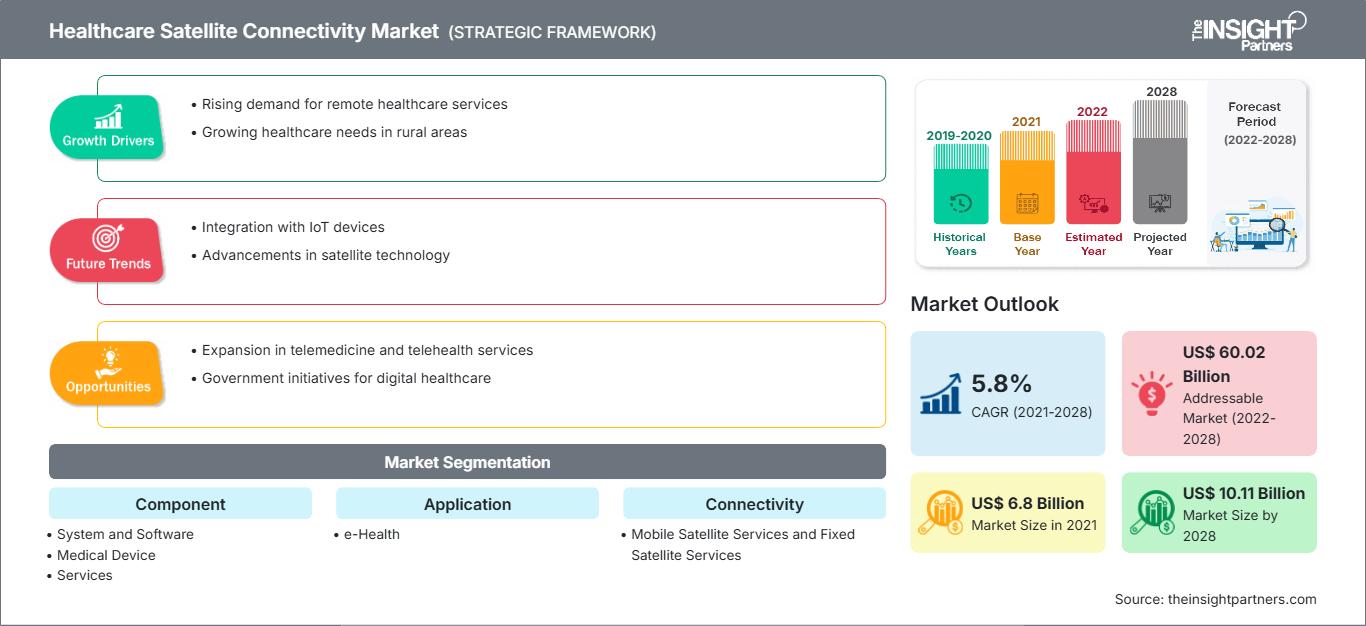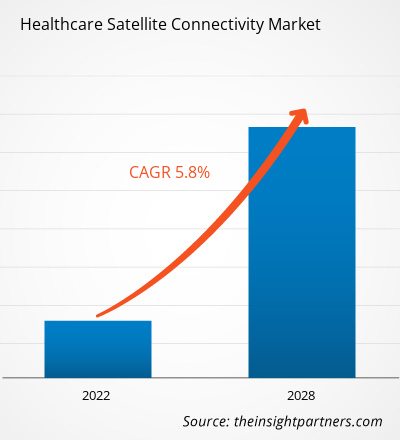Se prevé que el mercado de satélites sanitarios crezca de 6.797,22 millones de dólares estadounidenses en 2021 a 10.105,21 millones de dólares estadounidenses en 2028; se estima que crecerá a una tasa de crecimiento anual compuesta (TCAC) del 5,8% entre 2021 y 2028.
La conectividad satelital en el sector salud permite realizar diagnósticos y brindar atención médica a distancia desde la comodidad del hogar. Facilita la obtención de imágenes digitales, el monitoreo remoto de pacientes, el aprendizaje y la consulta en línea, así como el acceso a sesiones en vivo para mejorar los conocimientos de los profesionales médicos que se encuentran lejos.
El crecimiento del mercado de conectividad satelital en el sector salud se atribuye a factores como las iniciativas gubernamentales para la promoción y el desarrollo de soluciones basadas en conectividad satelital en el ámbito sanitario y la creciente adopción de la salud digital. Sin embargo, las preocupaciones en torno a la privacidad de los datos dificultan dicho crecimiento.
Perspectivas del mercado
Creciente industria de TI para la salud en economías emergentes
Obtendrá personalización gratuita de cualquier informe, incluyendo partes de este informe, análisis a nivel de país y paquetes de datos de Excel. Además, podrá aprovechar excelentes ofertas y descuentos para empresas emergentes y universidades.
Mercado de conectividad satelital para el sector salud: Perspectivas estratégicas

- Obtenga las principales tendencias clave del mercado que se describen en este informe.Esta muestra GRATUITA incluirá análisis de datos, que abarcarán desde tendencias de mercado hasta estimaciones y pronósticos.
Los sistemas de salud están experimentando un mayor compromiso del consumidor a nivel mundial. En los países en desarrollo, estos sistemas se están adaptando a la tecnología. Se observa una internacionalización de la atención médica, ya que marcas consolidadas, como la Clínica Cleveland (con sede en EE. UU.), expandieron sus negocios en los Emiratos Árabes Unidos, y empresas emergentes, como Babylon (con sede en el Reino Unido), una aplicación de diagnóstico de atención primaria basada en aprendizaje automático e inteligencia artificial, incursionaron en los mercados de China y Ruanda. Además, con el aumento de las inversiones en el sector de la salud de Asia Pacífico, las empresas emergentes de TI ofrecen oportunidades lucrativas para su crecimiento. Por ejemplo, en diciembre de 2020, DXY (una empresa china de portales de salud) recaudó 500 millones de dólares en una ronda de financiación Serie E liderada por Trustbridge Partners. Alodokter, una plataforma indonesia de tecnología sanitaria, recaudó 33 millones de dólares en una ronda de financiación Serie C. Se prevé que el creciente sector de TI para la salud en Asia Pacífico brinde oportunidades lucrativas para que las empresas expandan sus capacidades en toda la región. Asimismo, la pandemia de COVID-19 aceleró el uso de tecnologías de salud digital a nivel mundial. La pandemia priorizó las soluciones de monitoreo remoto. Los gobiernos de la región están promoviendo el uso de la telemedicina. Por ejemplo, en marzo de 2020, el gobierno indio publicó las Directrices de Práctica de Telemedicina para que los médicos colegiados pudieran prestar servicios sanitarios mediante telecomunicaciones y tecnologías digitales. Estas iniciativas ofrecerían oportunidades lucrativas para el crecimiento del mercado de portales para pacientes en los próximos años.
Información basada en componentes
El mercado de conectividad satelital para el sector salud, según sus componentes, se segmenta en dispositivos médicos, sistemas y software, y servicios. En 2021, el segmento de sistemas y software representó la mayor cuota de mercado. Se prevé que este mismo segmento registre la mayor tasa de crecimiento anual compuesto (TCAC) entre 2021 y 2028.
Información basada en aplicaciones
Por aplicación, el mercado de conectividad satelital para el sector salud se divide en eSalud y otros. En 2021, el segmento de eSalud ostentaba la mayor cuota de mercado. Sin embargo, se prevé que el segmento "otros" registre una mayor tasa de crecimiento anual compuesto (TCAC) en los próximos años.
Perspectivas basadas en la conectividad
En función de la conectividad, el mercado de conectividad satelital para el sector salud se divide en servicios satelitales móviles y servicios satelitales fijos. En 2021, el segmento de servicios satelitales fijos ostentaba la mayor cuota de mercado. Por otro lado, se prevé que el segmento de servicios satelitales móviles registre una mayor tasa de crecimiento anual compuesto (TCAC) durante el período de pronóstico.
Información basada en el usuario final
Según el usuario final, el mercado de conectividad satelital para el sector salud se segmenta en organizaciones de investigación clínica, hospitales y clínicas, laboratorios de investigación y diagnóstico, y otros. En 2021, el segmento de hospitales y clínicas representó la mayor cuota de mercado. Sin embargo, se prevé que el segmento de organizaciones de investigación clínica registre la mayor tasa de crecimiento anual compuesto (TCAC) en los próximos años.
El lanzamiento y la aprobación de productos son estrategias comunes que adoptan las empresas para expandir su presencia global y su cartera de productos. Además, los actores del mercado de conectividad satelital para el sector salud se centran en la estrategia de alianzas para ampliar su clientela, lo que, a su vez, les permite mantener su marca a nivel mundial.
Perspectivas regionales del mercado de conectividad satelital para el sector salud
Los analistas de The Insight Partners han explicado en detalle las tendencias y los factores regionales que influyen en el mercado de conectividad satelital para el sector salud durante el período de pronóstico. Esta sección también analiza los segmentos y la geografía del mercado de conectividad satelital para el sector salud en Norteamérica, Europa, Asia Pacífico, Oriente Medio y África, y Sudamérica y Centroamérica.
Alcance del informe de mercado de conectividad satelital para el sector salud
| Atributo del informe | Detalles |
|---|---|
| Tamaño del mercado en 2021 | 6.800 millones de dólares estadounidenses |
| Tamaño del mercado para 2028 | 10.110 millones de dólares estadounidenses |
| Tasa de crecimiento anual compuesto global (2021 - 2028) | 5,8% |
| Datos históricos | 2019-2020 |
| período de previsión | 2022-2028 |
| Segmentos cubiertos | Por componente
|
| Regiones y países cubiertos | América del norte
|
| Líderes del mercado y perfiles de empresas clave |
|
Densidad de los actores del mercado de conectividad satelital para el sector salud: comprensión de su impacto en la dinámica empresarial
El mercado de conectividad satelital para el sector salud está creciendo rápidamente, impulsado por la creciente demanda de los usuarios finales debido a factores como la evolución de las preferencias de los consumidores, los avances tecnológicos y una mayor conciencia de los beneficios del producto. A medida que aumenta la demanda, las empresas amplían su oferta, innovan para satisfacer las necesidades de los consumidores y aprovechan las tendencias emergentes, lo que impulsa aún más el crecimiento del mercado.

- Obtenga una visión general de los principales actores del mercado de conectividad satelital para el sector salud.
El informe segmenta el mercado de conectividad satelital para el sector salud de la siguiente manera:
Mercado de conectividad satelital para el sector salud – por componente
- Sistema y software
- Gestión remota de dispositivos
- Gestión del ancho de banda de la red
- Análisis de datos
- Seguridad de las aplicaciones
- Seguridad de la red
- Dispositivo médico
- Dispositivo externo portátil
- Dispositivo médico implantado
- Dispositivo médico estacionario
- Servicios
- Servicios de integración de sistemas
- Consultante
- Formación y educación
- Servicios de soporte y mantenimiento
Mercado de conectividad satelital para el sector salud: por aplicación
- salud electrónica
- Telemedicina
- Operaciones clínicas
- Otros
Mercado de conectividad satelital para el sector salud – por conectividad
- Servicios móviles por satélite
- Servicios fijos por satélite
Mercado de conectividad satelital para el sector salud: por usuario final
- Organizaciones de Investigación Clínica
- Hospitales y clínicas
- Laboratorios de Investigación y Diagnóstico
- Otros
Mercado de conectividad satelital para el sector salud – por geografía
- América del norte
- A NOSOTROS
- Canadá
- México
- Europa
- Reino Unido
- Alemania
- Francia
- Italia
- España
- El resto de Europa
- Asia Pacífico
- Porcelana
- Japón
- India
- Australia
- Corea del Sur
- Resto de Asia Pacífico
- Oriente Medio y África
- Emiratos Árabes Unidos
- Arabia Saudita
- Sudáfrica
- Resto de Oriente Medio y África
- América del Sur y Central
- Brasil
- Argentina
- El resto de Sudamérica y Centroamérica
Perfiles de empresas
- Inmarsat Global Limited
- Sistemas de red Hughes
- SES SA
- X2nSat
- Comunicaciones de la expedición
- Estrella global
- EUTELSAT COMUNICACIONES SA
- Propiedad intelectual de AT&T
- DISH Network LLC
- Redes Ligado
- Análisis histórico (2 años), año base, pronóstico (7 años) con CAGR
- Análisis PEST y FODA
- Tamaño del mercado, valor/volumen: global, regional y nacional
- Industria y panorama competitivo
- Conjunto de datos de Excel
Informes recientes
Informes relacionados
Testimonios
Razón para comprar
- Toma de decisiones informada
- Comprensión de la dinámica del mercado
- Análisis competitivo
- Información sobre clientes
- Pronósticos del mercado
- Mitigación de riesgos
- Planificación estratégica
- Justificación de la inversión
- Identificación de mercados emergentes
- Mejora de las estrategias de marketing
- Impulso de la eficiencia operativa
- Alineación con las tendencias regulatorias






















 Obtenga una muestra gratuita para - Mercado de conectividad satelital para atención médica
Obtenga una muestra gratuita para - Mercado de conectividad satelital para atención médica